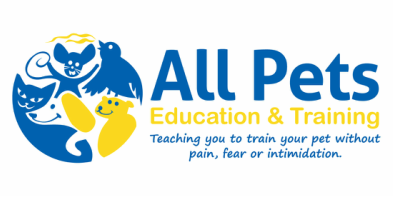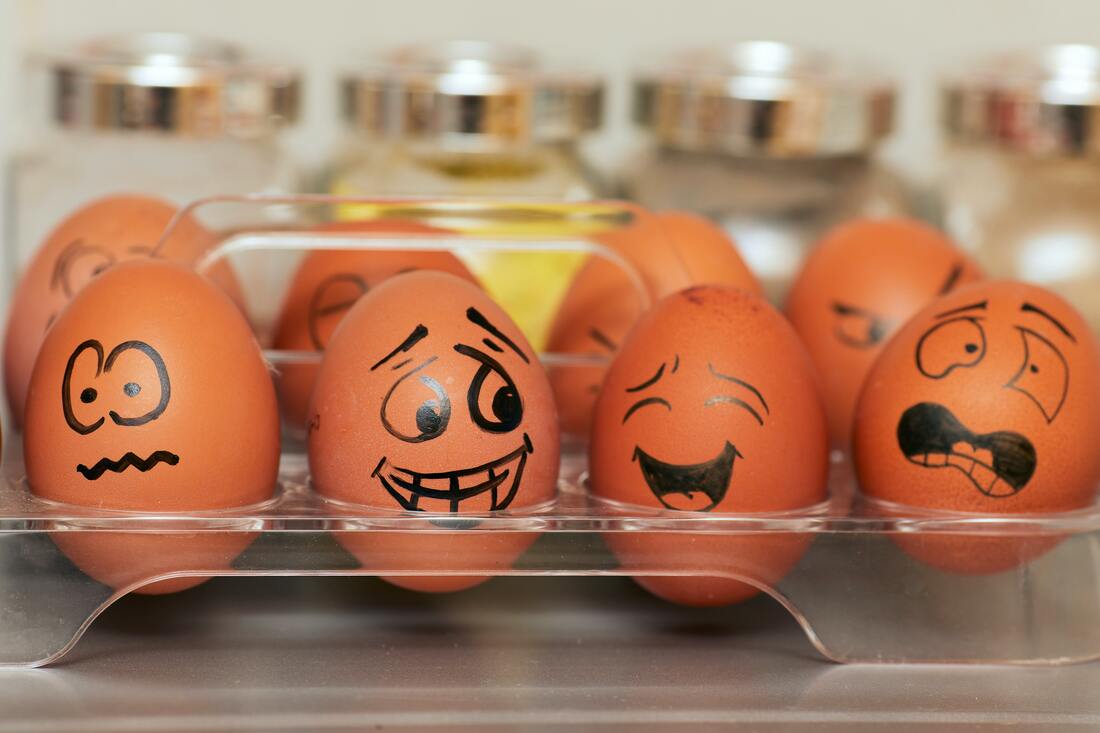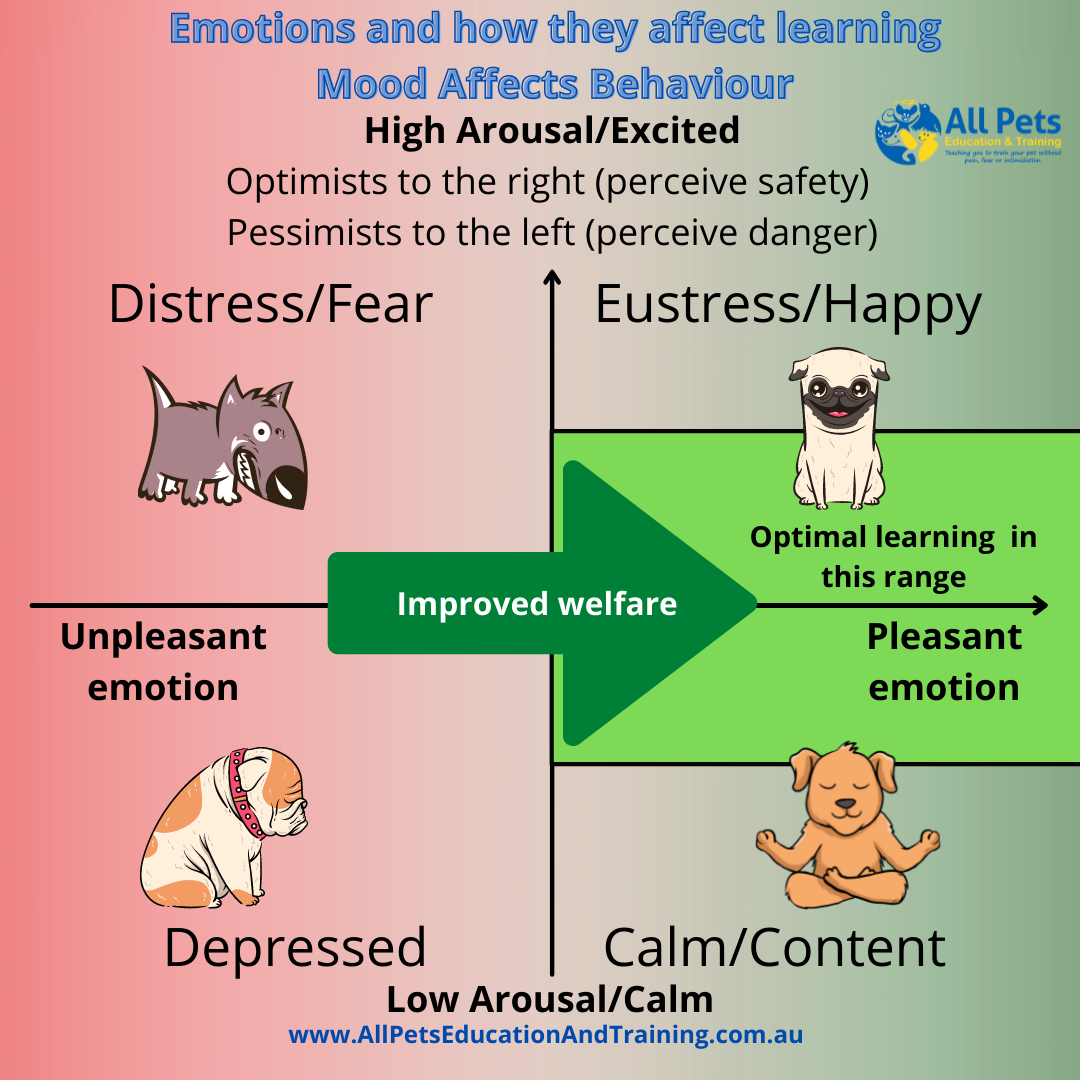Emotions and how they affect our pets
Jan 2022
How do emotions impact our pets and their learning?
Emotions change the structure and function of the brain, this then affects behaviour and well being.
Emotions matter! (Westlund)
Emotions range from unpleasant (aversive) to pleasant (nice). They are not neutral. They also differ in the level of arousal – low to high.
This creates the Core Effect Space.
Eustress (good stress), happy and content are on the right side of the quadrants, anger, fear, distress and depression on the left side. Welfare improves as we move toward the right side of the quadrants.
Emotions change the structure and function of the brain, this then affects behaviour and well being.
Emotions matter! (Westlund)
Emotions range from unpleasant (aversive) to pleasant (nice). They are not neutral. They also differ in the level of arousal – low to high.
This creates the Core Effect Space.
Eustress (good stress), happy and content are on the right side of the quadrants, anger, fear, distress and depression on the left side. Welfare improves as we move toward the right side of the quadrants.
Emotions can change quickly. They are difficult to measure, but what we can measure and record is the behaviours associated with emotions.
Mood states will also influence the perception of the animal – ie do they perceive cues of safety or something of danger. Think of the optimists and pessimists amongst us (and our pets).
This influence will be part of our decision making, and therefore the behaviour displayed as part of this perception.
Ie, if your dog is worried about the world, he is more likely to assume something is dangerous, and also more likely to display reactive behaviour to create distance between the thing.
Optimists have improved welfare, pessimists reduced welfare.
Now considering the core effect space again, how does this affect learning?
At very low arousal and high arousal – learning is reduced. At intermediate levels – learning is optimal.
Moving forward, lets consider the experience of the animal.
Neutral – not important to the animal – it doesn’t predict anything good or bad.
Pleasant experiences – the animal will work for and aim to gain these, and can be used as reinforcers
Unpleasant experiences - the animal will work to avoid. As much as I choose not to use these, these can inadvertently happen, and we cannot control every aspect of the environment. The animal will also take in to account the predictors of inadvertent punishment too. This is something we should be looking out for.
How we behave will also guide our animal through core effect space and therefore the emotions they experience. This could include the addition of reinforcers, the removal of reinforcers (this may create frustration and be unpleasant), punishing the animal and so forth.
By encouraging our animals to spend more time on the right of the core effect space, we grow their resilience and ability to bounce back on the occasion that do have an unpleasant experience such as a fright, vet visit etc. By building a solid foundation of pleasant experiences, we empower our animals.
Another important thing to remember, is emotions spread backwards in time (classical conditioning), and we can use this to our advantage. The pleasurable event is preceded by other things happening, these other things, actually become the predictor of pleasurable events. The emotions associated with the final event, will infect the preceding events.
So an example, your dog loves a walk, you pick up the leash and he gets excited. But remember, this can also work against us. If the final event is unpleasant, the things that come before it will be infected with the negative emotions. Maybe your dog gets car sick, or your cat only sees the cat crate for vet visits. You bring out the car harness or cat crate and your animals will avoid these things.
Now its our job to imagine how we can grow our pets optimism and use our knowledge to improve their welfare.
Think of optimism as how an individual (dog, person or any other being) perceives a new or ambiguous situation. Do they see it in a positive way or a negative way? You know the glass ½ full or empty scenario.. novel scenario? In dogs their level of optimism can determine how they react to:
- Another dog, whether that dog is giving ambiguous signals, is a rude dog or is just another very polite and normal dog;
- A new or unusual object (an umbrella, a hat, a new object in the house, even moving an existing object around the house);
- A certain type of person (size, shape, beard, hat, coat or anything new).
Anything and everything in their environment could potentially freak them out. The pessimist is going to potentially worry about anything and everything and they may deal with that by “saving themselves” (that’s often why reactive dogs that are scared of other dogs….move toward the other dog to scare it off), or alternatively totally shutting down.
OPTIMISM = anything new is nothing to be worried about! Take it all in, enjoy and be happy!
PESSIMISM = anything new is going to hunt me down / eat me / kill me / basically impact me in a negative way. (Mitchell and Langman)
Now think of confidence like a muscle! You can change, develop and grow optimism very easily and you can improve your dogs overall confidence in everyday life situations. (Mitchell and Langman)
How?
Think about antecedent (what sets the scene) arrangements, the consequences and how they change your pets behaviour and emotional state.
Train for the situation and not in it - give your pet the skills to succeed before expecting massive changes.
Play, short, fun training games and provide challenges, ensuring that your pet has frequent small wins is a great way to grow confidence. If you do this right, at the same time your pet will be receiving a nice hit of dopamine – the molecule of more. This will drive your pet to train, focus and grow more.
Talk to a qualified reward based dog trainer, and even better a Certified Pro Dog Trainer as we can help you select or design games best suited to your individual dog and his or her struggles.
Works Cited
Jaak Panksepp, and Oxford University Press. Affective Neuroscience : The Foundations of Human and Animal Emotions. Oxford Et Al., Oxford University Press, Dr, 2014.
Mitchell, Tom, and Lauren Langman. Optimism Rocks. Absolute Dogs, 2018.
Mitchell, Tom, and Lauren Langman. Dog Training Transformation. Gloucester, The Choir Press, 2020.
---. The Naughty but Nice Revolution : How Thousands of Owners of Barking, Lunging, Reactive Dogs Are Transforming Their Struggles through Games and so CAN YOU : A Practical Guide. Gloucester, The Choir Press, 2020.
Westlund, Karolina. “Illis ABC – Animal Behaviour Consulting.” Illis ABC - Animal Behaviour Consulting, illis.se/en/. Accessed 23 Jan. 2022.


